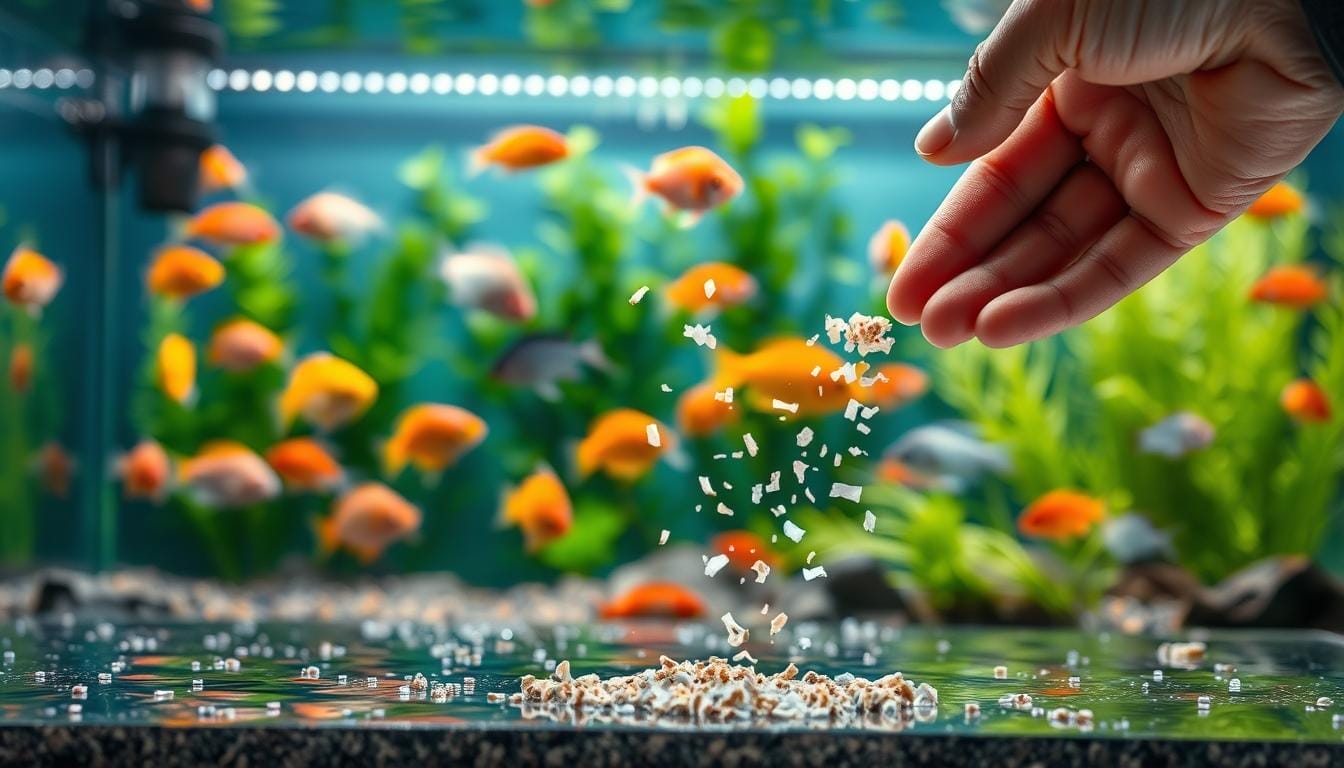
Mastering Fish Feeding: Tips for a Healthy Aquarium
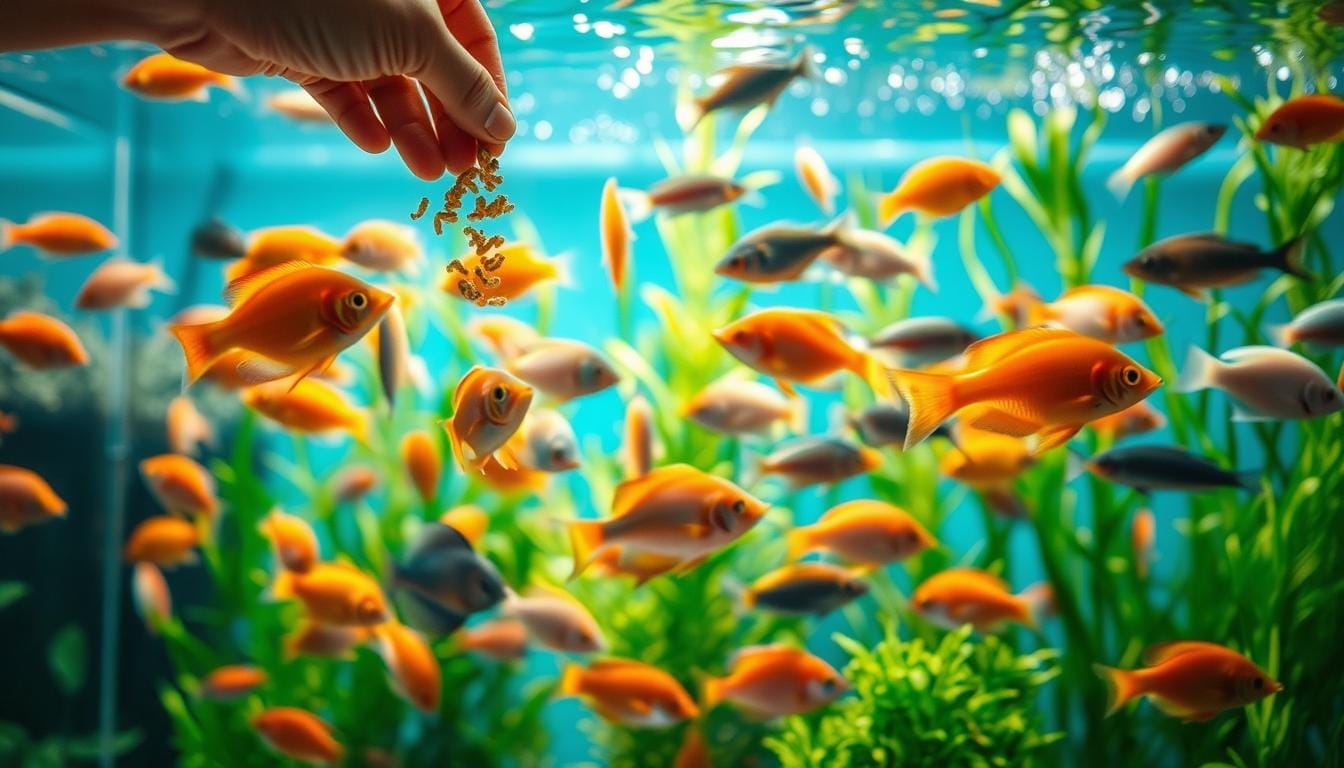
Did you know 60% of aquarium issues stem from improper nutrition practices? Your aquatic companions rely entirely on you for their dietary needs, making every meal a critical factor in their well-being. This guide reveals simple yet powerful strategies to create a vibrant underwater world where your pets flourish.
You’ll discover how to balance nutritional requirements with water quality management. Overlooking this connection is why many enthusiasts struggle with cloudy tanks or sluggish swimmers. We’ll show you how to avoid these pitfalls while enhancing your aquarium’s natural beauty.
Proper nourishment does more than sustain life – it unlocks dazzling colors and active behaviors. Learn to select food that matches your species’ natural diet, whether they’re herbivores, carnivores, or omnivores. Timing matters too: we’ll help you establish routines that prevent overfeeding while supporting healthy growth.
Did you spot the common mistake in that last paragraph? Many aquarists don’t realize how quickly uneaten meals degrade water conditions. Our methods keep tanks cleaner longer, giving you more time to enjoy your aquatic paradise instead of constant maintenance.
By understanding these principles, you’ll create an environment where every inhabitant thrives. Let’s transform your tank into a living masterpiece through science-backed feeding techniques that work for beginners and experts alike.
Introduction to Fish Feeding for a Healthy Aquarium
Starting your aquatic journey means learning a new language—the silent signals your tank inhabitants use to communicate their needs. Those first flakes floating in the water aren’t just meals; they’re building blocks for a thriving ecosystem. Three key questions shape every successful feeding strategy: what to serve, how much to give, and when to offer it.
Natural habitats teach us volumes about dietary needs. Herbivores graze constantly on plants, while carnivores hunt protein-rich meals. Omnivores adapt to whatever’s available. Your tank should reflect these patterns through carefully chosen food types and schedules that match your pets’ biological rhythms.
Watch closely during mealtimes. Active surface feeders need floating pellets, while bottom dwellers require sinking varieties. Overfeeding clouds water quality faster than you’d expect—leftover meals decay into harmful toxins. A balanced approach maintains clarity while supporting vibrant colors and energy levels.
Successful aquarists treat feeding as a dialogue. Adjust portions based on how quickly your aquatic community consumes offerings. Rotate between high-quality flakes, algae wafers, and occasional live treats to cover all nutritional bases. Remember: consistency matters more than quantity.
Understanding Dietary Preferences of Fish
Your aquarium’s inhabitants speak through their eating habits – you just need to interpret their nutritional language. Aquatic species evolved distinct feeding patterns that directly impact their health and behavior. Matching these natural rhythms transforms mealtimes into growth opportunities rather than guesswork.
Herbivores, Carnivores, and Omnivores Explained
Plant-focused species like silver dollars and plecos possess specialized digestive systems. Their high-fiber needs require multiple algae wafers or blanched veggies daily. Watch them nibble constantly – this grazing mimics wild behavior where food sources are abundant but low in calories.
Predatory species such as oscars operate differently. Their metabolism thrives on infrequent, protein-packed meals like bloodworms or shrimp. Offering large portions daily can overwhelm their systems – three smaller servings weekly often work better.
Versatile omnivores like mollies adapt to varied diets. Combine spirulina flakes with brine shrimp for balanced nutrition. This flexibility makes them ideal for community tanks where multiple food types are present.
Track how quickly your aquatic community consumes meals. Adjust schedules based on appetite changes – active foragers may need extra plant matter, while shy bottom-dwellers benefit from sinking pellets. Recognizing these patterns prevents waste and maintains water clarity.
Identifying What to Feed Your Fish
Choosing the right meals for your aquatic friends transforms their health and tank harmony. Start by researching their wild diets – this knowledge helps you recreate nature’s pantry in your aquarium. Whether your pets nibble plants or hunt prey, their food choices directly impact energy levels and water clarity.
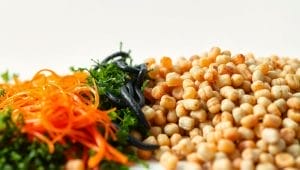
Nature’s Bounty vs Modern Nutrition
Live or frozen options like brine shrimp and bloodworms spark natural hunting instincts. These protein-rich treats keep carnivorous species engaged while providing essential amino acids. Many aquarists report brighter colors in their pets after introducing daphnia – tiny crustaceans packed with carotenoids.
Commercial formulas simplify mealtime with balanced blends. Look for quality feed containing spirulina for herbivores or krill meal for meat-eaters. Reputable brands fortify their products with vitamins that prevent deficiencies – a lifesaver for busy caretakers.
Three factors determine success:
- Match portion sizes to mouth dimensions (neon tetras need crumbs, oscars require chunky pellets)
- Rotate between freeze-dried tubifex worms and algae wafers for variety
- Remove uneaten material within 5 minutes to preserve water quality
Combine both approaches for optimal results. Alternate days between frozen treats and premium flakes to cover all nutritional bases. This strategy satisfies instinctual behaviors while ensuring consistent vitamin intake – the perfect recipe for thriving fish species.
Determining Proper Feeding Quantities
The secret to a thriving tank lies in what’s left after meals. Observe your aquatic companions during their dining sessions – their enthusiasm (or lack of it) tells you everything. New setups demand extra caution: biological filters need time to handle waste, making portion control your best defense against cloudy water.
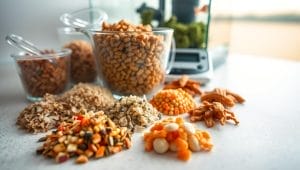
Observing Behavior in Your Aquarium
Watch how quickly your pets approach food. Surface swimmers gulping flakes within seconds? Bottom dwellers ignoring sinking pellets? These clues help tailor quantities to actual needs. The 2-minute rule works wonders – if meals vanish faster, slightly increase portions next time.
Adjusting Portions for Activity Levels
Active species might need slightly larger quantities during warmer months when their metabolism speeds up. Sedentary types often thrive on smaller, frequent meals. Three factors guide adjustments:
- Water temperature changes
- Breeding behaviors
- Visible interest in food
Always remove leftovers within five minutes using a siphon. This practice prevents ammonia spikes while teaching you about your tank’s perfect quantity balance. Remember: a hungry aquatic friend is safer than one swimming in decaying meals.
Establishing an Effective Feeding Schedule
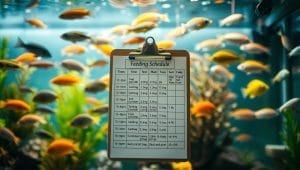
Timing transforms tank care from a chore to a rhythm your aquatic friends recognize. Start by matching their natural feeding patterns – early morning and evening times work best. Turn on lights 30 minutes before breakfast, letting inhabitants wake gradually. After dinner, maintain illumination for another half-hour to support digestion.
Most tanks thrive with one or two small meals per day. Watch how quickly food disappears – this reveals if portions need adjusting. Pro tip: skip feeding one day each week. This rest period helps clear digestive systems, mimicking wild conditions where food isn’t always available.
Three rules keep schedules effective:
- Serve carnivores larger portions every other day
- Offer herbivores nibble-worthy algae wafers twice daily
- Remove uneaten food within five minutes
Consistency matters more than quantity. Your pets will anticipate meals at set times, reducing stress. Adjust for seasonal changes – warmer water speeds metabolism, requiring slightly more food. Stick to routines, and you’ll notice cleaner water and livelier swimmers within weeks.
Role of Water Temperature and Light in Feeding
Your aquarium’s heartbeat syncs with two silent conductors – thermal conditions and illumination. These elements shape metabolic rhythms and mealtime success more than you might realize. Maintaining proper water temperature isn’t just about comfort; it’s the engine driving digestion and nutrient absorption.
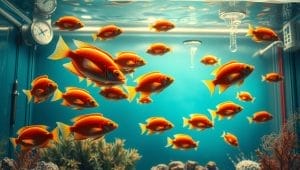
Metabolic Throttle: Thermal Dynamics
Warmer waters (within species-specific ranges) act like a gas pedal for energy use. For every degree increase, metabolic rates jump approximately 10%, as shown in studies on aquatic species. This means danios in a 78°F tank process meals 30% faster than those at 75°F – requiring three daily feedings instead of two.
Newly hatched fry demonstrate this dramatically. Their rapid growth demands constant fuel, particularly in heated breeding tanks. But there’s a catch: the feeding-temperature relationship follows a bell curve. Appetite peaks at optimal ranges then plummets if waters become too warm or cold.
Three signs your schedule needs thermal adjustments:
- Food remains uneaten after 2 minutes
- Aquatic pets linger near heaters or avoid warm zones
- Growth rates stall despite consistent portions
Light completes this equation. Morning illumination triggers hunting behaviors, while dusk signals digestion. Sync feeding times with natural photoperiods – 30 minutes after lights on and 1 hour before lights off works for most setups. This rhythm reduces stress and maximizes nutrient uptake.
Techniques for Targeted Feeding in Mixed-Species Aquariums
Creating harmony in a community tank begins at feeding time. Your aquatic residents have distinct dining preferences shaped by their natural habitats and personalities. Surface swimmers race to grab floating morsels, while shy bottom-dwellers wait patiently near hiding spots.
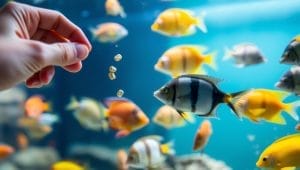
Start by mapping your tank’s vertical zones. Floating flakes satisfy top feeders like bettas, while sinking wafers reach catfish patrolling the substrate. Mid-water species thrive on slow-sinking pellets that mimic drifting prey. This layered approach ensures every inhabitant gets their share without competition.
Custom Tools for Selective Nutrition
Timid feeders often miss meals in busy tanks. Try using a turkey baster to deliver bloodworms directly to reclusive loaches. Feeding rings contain floating food for surface-oriented species, preventing it from scattering beyond reach. Pair these tools with a varied menu to meet all dietary needs.
Observe your tank during meals. Aggressive eaters might need distraction tactics – drop algae wafers at opposite ends simultaneously. For a balanced ecosystem, combine three food types each session:
- Fast-floating options for top dwellers
- Gel-based meals that sink gradually
- Heavy tablets for bottom cleaners
Adjust portions based on consumption speed. Leftovers in any zone signal overfeeding – remove them promptly to maintain water quality. With practice, you’ll develop a feeding system that keeps every swimmer nourished and active.
Utilizing Frozen, Live, an
Elevate your aquarium’s health by exploring the dynamic world of specialized nutrition options. Frozen and live foods offer targeted benefits that prepared formulas can’t match—think bloodworms for carnivores or spirulina blends for plant-eaters. These choices mirror natural diets while boosting coloration and activity levels.
Frozen options like brine shrimp retain more nutrients than dried alternatives, making them ideal for picky eaters. Live daphnia or blackworms stimulate hunting instincts, especially in species that ignore stationary meals. Pair these with high-quality pellets or flakes to ensure balanced vitamin intake.
For consistent results, thaw frozen cubes in tank water before serving and remove uneaten portions promptly. Combine these practices with smart feeding strategies to maintain water clarity. Your aquatic community will thrive when their menu aligns with both instinct and science.
FAQ
How do I know if my aquatic pets are herbivores or carnivores?
Observe their natural behaviors and mouth structures. Species like silver dollars thrive on algae wafers, while bettas need protein-rich pellets. Research your specific tank residents or consult a local aquatics expert for tailored advice.
What’s the best way to avoid overfeeding?
Offer small portions they can finish in 2-3 minutes, twice daily. Remove uneaten bits with a net to maintain water quality. Adjust amounts if you notice leftover food or sluggish behavior after meals.
Does room temperature affect how often I should offer meals?
Yes! Warmer water (75-80°F) speeds up metabolism, requiring more frequent feedings. Cooler environments slow digestion—species like goldfish in unheated tanks might need smaller, spaced-out portions. Always monitor activity levels.
How can I ensure shy and active tankmates both get enough nutrition?
Use sinking pellets for bottom dwellers like corydoras and floating flakes for surface feeders. Create feeding zones with decor or plant barriers. Brands like Hikari offer slow-sinking options for mid-water species.
Are frozen foods safer than live options?
Frozen brine shrimp or bloodworms from trusted suppliers like Omega One reduce disease risks compared to live prey. Thaw portions in tank water before serving, and avoid refreezing unused chunks to preserve quality.
Can I use automatic feeders for vacation care?
Programmable models like Eheim Daily Feed work well for dry foods during short trips. Test settings beforehand, and ask a friend to check water parameters periodically. Avoid relying solely on automation for more than 5-7 days.





